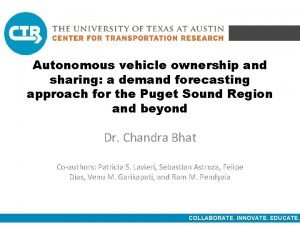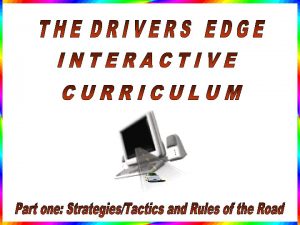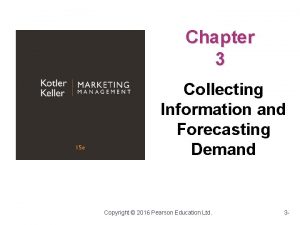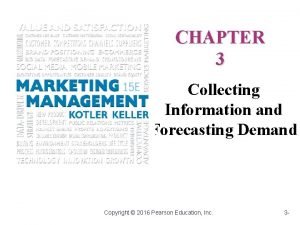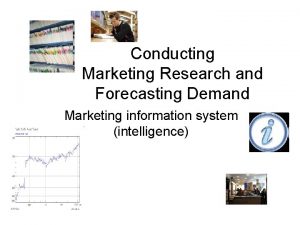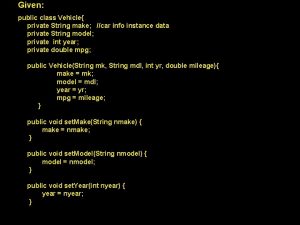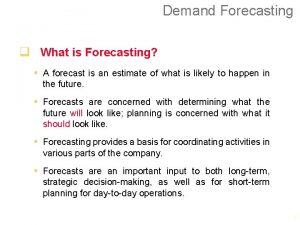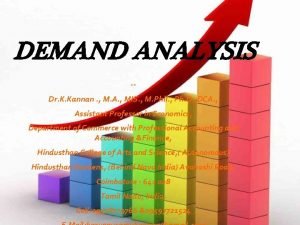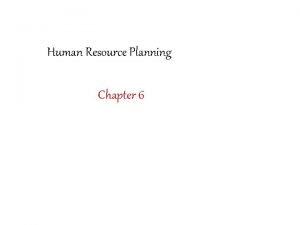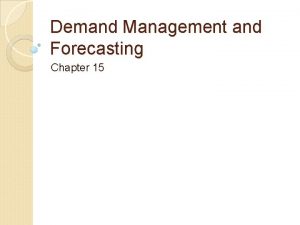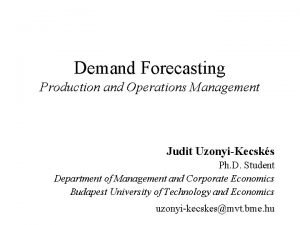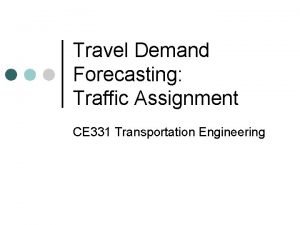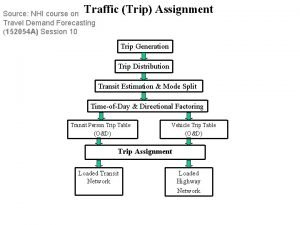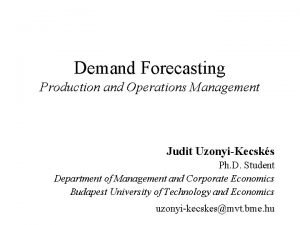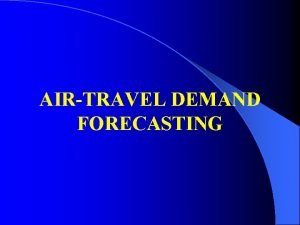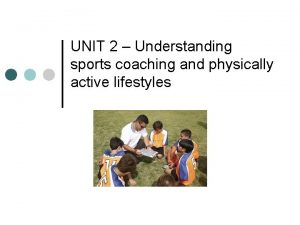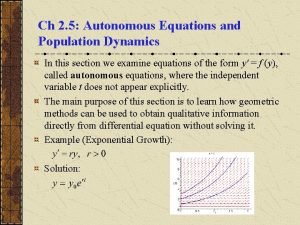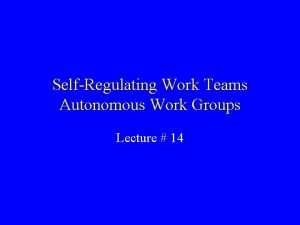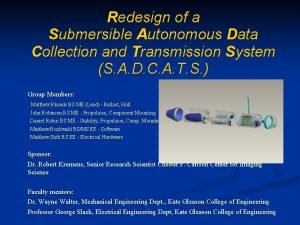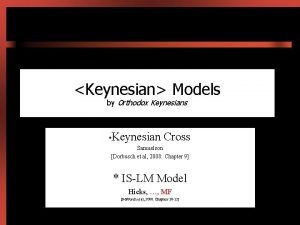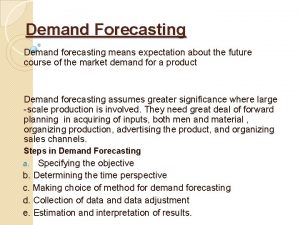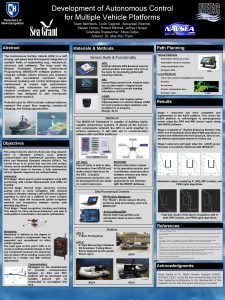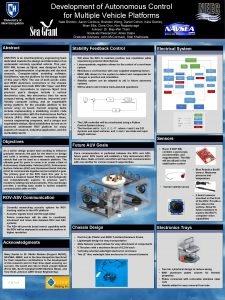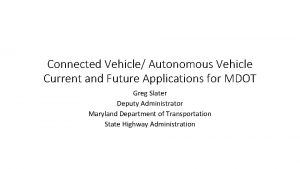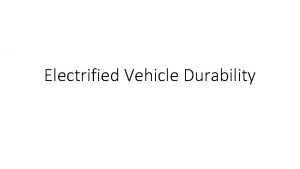Autonomous vehicle ownership and sharing a demand forecasting























































- Slides: 55

Autonomous vehicle ownership and sharing: a demand forecasting approach for the Puget Sound Region and beyond Dr. Chandra Bhat Co-authors: Patricia S. Lavieri, Sebastian Astroza, Felipe Dias, Venu M. Garikapati, and Ram M. Pendyala COLLABORATE. INNOVATE. EDUCATE.

MOTIVATION COLLABORATE. INNOVATE. EDUCATE.

The Context q Autonomous Vehicles: Vehicles that are able to guide themselves from an origin point to a destination point desired by the individual q Individual yields full control to artificial intelligence technology Ø Individual decides an activity-travel plan (or tour-specific information) Ø The plan is keyed into the car’s intelligence system Ø The car (or an external entity connected to the car) decides on a routing and circuit to complete the plan COLLABORATE. INNOVATE. EDUCATE.

CTR Research • Overview • Autonomous Technology • Connected Technology • CARSTOP project • Adoption • Societal Effects • Planning COLLABORATE. INNOVATE. EDUCATE.

Did you know? • All New 2018 Vehicles Must Have A Back-Up Camera • Roughly 200 people are killed each year and another 14, 000 are injured in so-called backover accidents, when drivers reverse over another person without noticing him or her. • 20 Automakers (99% of the US market) have agreed to make automatic braking standard by 2022 • IIHS estimates that automated braking at full penetration would have prevented 700, 000 crashes in 2013 (13% of all crashes) • “The data show that the Tesla vehicles crash rate dropped by almost 40 percent after Autosteer installation. ” – NHTSA Report • Tesla expects a 90% drop with Autopilot 2 • Tesla is selling insurance in Australia and Hong Kong COLLABORATE. INNOVATE. EDUCATE.

Automated Vehicles and Transportation Technology Infrastructure Traveler Behavior COLLABORATE. INNOVATE. EDUCATE.

Two Types of Technology Self-Driving Vehicle (e. g. , Google) Connected Vehicle AI located within the vehicle AI wirelessly connected to an external communications network “Inward-facing” with the vehicle receiving “Outward-facing” in that sensors blast external environment information outward from the vehicle to collect through wireless connectivity, and information without receiving data inward operational commands from an external from other sources entity AI used to make autonomous decisions on what is best for the individual driver Used in cooperation with other pieces of information to make decisions on what is “best” from a system optimal standpoint AI not shared with other entities beyond the vehicle AI shared across multiple vehicles A more “Capitalistic” set-up A more “Socialistic” set-up COLLABORATE. INNOVATE. EDUCATE.

PRESENT DAY Regular Traffic Conditions COLLABORATE. INNOVATE. EDUCATE.

PRESENT DAY Icy Patch COLLABORATE. INNOVATE. EDUCATE.

PRESENT DAY Incident COLLABORATE. INNOVATE. EDUCATE.

PRESENT DAY Lane blocking, traffic slow down COLLABORATE. INNOVATE. EDUCATE.

PRESENT DAY Congestion buildup, late lane changes COLLABORATE. INNOVATE. EDUCATE.

PRESENT DAY Congestion propagation to frontage, ramp backed up COLLABORATE. INNOVATE. EDUCATE.

V 2 V Regular Traffic Conditions COLLABORATE. INNOVATE. EDUCATE.

V 2 V Icy Patch COLLABORATE. INNOVATE. EDUCATE.

V 2 V Incident: Information propagation COLLABORATE. INNOVATE. EDUCATE.

V 2 V Preemptive lane changing, freeway exit COLLABORATE. INNOVATE. EDUCATE.

V 2 I Re-optimization of signal timing, upstream detours INCIDENT AHEAD TAKE DETOUR COLLABORATE. INNOVATE. EDUCATE.

AUTONOMOUS Regular Traffic Conditions COLLABORATE. INNOVATE. EDUCATE.

AUTONOMOUS Icy Patch COLLABORATE. INNOVATE. EDUCATE.

AUTONOMOUS Avoidance of icy patch, no incident COLLABORATE. INNOVATE. EDUCATE.

AUTONOMOUS Traffic slowdown, late lane changing, congestion COLLABORATE. INNOVATE. EDUCATE.

AUTONOMOUS + V 2 X Icy Patch COLLABORATE. INNOVATE. EDUCATE.

AUTONOMOUS + V 2 X Avoidance of icy patch, no incident COLLABORATE. INNOVATE. EDUCATE.

AUTONOMOUS + V 2 V Information propagation, preemptive lane changing, freeway exit COLLABORATE. INNOVATE. EDUCATE.

AUTONOMOUS + V 2 I Re-optimization of signal timing, upstream detours INCIDENT AHEAD TAKE DETOUR COLLABORATE. INNOVATE. EDUCATE.

Shared Autonomous Vehicles (SAV) vs. Private Ownership q Private ownership Ø Chauffeuring household members q Shared Autonomus Vehicles (SAV) Ø Acquired by mobility providers (Uber, Lyft, car 2 go…) Ø Travelers purchasing transportation Ø$/trip Ø$/mile Ø$/minute COLLABORATE. INNOVATE. EDUCATE.

Impacts on the Transportation Network and on the Environment PRIVATELY OWNED AV High emptyvehicle-miles traveled Reduced AV owners’ value of travel time Cancel any network operation gain due to AV platooning Increased energy consumption Increased congestion SHARED AV Low empty-vehicle -miles traveled Network operation gain due to AV platooning Subsided fares for social inclusion Fares control value of travel time Reduced energy consumption Low congestion COLLABORATE. INNOVATE. EDUCATE.

Possible AV impacts on Land-Use Patterns q Live and work farther away Ø Use travel time productively Ø Access more desirable and higher paying job Ø Attend better school/college q Visit destinations farther away Ø Access more desirable destinations for various activities Ø Reduced impact of distances and time on activity participation q Influence on developers Ø Sprawled cities? Ø Impacts on community/regional planning and urban design COLLABORATE. INNOVATE. EDUCATE.

Impacts on Mode Choice Automated vehicles combine the advantages of public transportation with that of traditional private vehicles Ø Catching up on news Ø Texting friends Ø Reading novels Ø Flexibility Ø Comfort Ø Convenience What will happen to public transportation? Also automated vehicles may result in lesser walking and bicycling shares Time less of a consideration So, will Cost be the main policy tool to influence behavior? COLLABORATE. INNOVATE. EDUCATE.

Impacts on Mode Choice q Driving personal vehicle more convenient and safe q Traditional transit captive market segments now able to use auto (e. g. , elderly, disabled) q Reduced reliance/usage of public transit? q However, autonomous vehicles may present an opportunity for public transit and car sharing Ø Lower cost of operation (driverless) and can cut out low volume routes Ø More personalized and reliable service - smaller vehicles providing demand-responsive transit service Ø No parking needed – kiss-and-ride; no vehicles “sitting” around Ø 20 -80% of urban land area can be reclaimed Ø Chaining may not discourage transit use COLLABORATE. INNOVATE. EDUCATE.

Central Role of Time Use • Notion of time is central to activity-based modeling – Explicit modeling of activity durations (daily activity time allocation and individual episode duration) – Treat time as “continuous” and not as “discrete choice” blocks • Activity engagement is the focus of attention – Travel patterns are inferred as an outcome of activity participation and time use decisions – Continuous treatment of time dimension allows explicit consideration of time constraints on human activities • Reconcile activity durations with network travel durations (feedback processes) 32 COLLABORATE. INNOVATE. EDUCATE.

In Summary • ABM should… – Capture the central role of activities, time, and space in a continuum – Explicitly recognize constraints and interactions – Represent simultaneity in behavioral choice processes – Account for heterogeneity in behavioral decision hierarchies – Incorporate feedback processes to facilitate integration with land use and network models • Sim. AGENT does it all and more… 33 COLLABORATE. INNOVATE. EDUCATE.

RESEARCH QUESTION COLLABORATE. INNOVATE. EDUCATE.

Objective q To quantify the potential initial demand for AV technology in the Puget Sound Region (PSR) of the State of Washington in the United States. q Forecasting process was divided into two phases: Ø Behavioral framework for AV adoption interest based on latent psychological constructs such as environmental consciousness, technology-savviness, and AVapprehensiveness. Ø We used Census data of the same region to generate a synthetic population for each Census Block Group and then we predicted how the different demands would be geographically distributed across the PSR. q This prediction is then translated into a visualization of the results. COLLABORATE. INNOVATE. EDUCATE.

About adoption q Two forms of adoption were considered: Ø AV ownership and Ø AV sharing. q Individuals were grouped into one of four different categories: Ø interested in AV ownership, Ø interested in AV sharing, Ø interested in both options, and Ø not interested in AV adoption. COLLABORATE. INNOVATE. EDUCATE.

BEHAVIORAL FRAMEWORK COLLABORATE. INNOVATE. EDUCATE.

Modeling Individual preferences for ownership and sharing AVs q Consumer interest in the adoption and use of AVs q Impacts of Ø individual lifestyle preferences, Ø attitudinal factors, and Ø current use of disruptive transportation services. q Modeling methodology based on the GHDM approach q Data: 2014 and 2015 Puget Sound Regional Travel Study. COLLABORATE. INNOVATE. EDUCATE.

Individual preferences for ownership and sharing AVs COLLABORATE. INNOVATE. EDUCATE.

DATA COLLABORATE. INNOVATE. EDUCATE.

Data q Survey with 1800 individuals in the Puget sound Region q AV interest Ø Not interested in AV sharing or AV ownership (68. 5%) Ø Interested in AV sharing only (7. 6%) Ø Interested in AV ownership only (8. 5%) Ø Interested in AV sharing and AV ownership (15. 4%) q 51% reside in low-density neighborhoods q 12% reside in zero-vehicle households and 39% resided in one-vehicle households q 14% used a ride-sourcing service at least once in their lifetime q 9. 2% used a car-sharing service at least once in their lifetime COLLABORATE. INNOVATE. EDUCATE.

Lifestyle Variables q Green lifestyle Ø Frequency of transit usage Ø Importance of a walkable neighborhood and being close to activities in choice of home location Ø Importance of being close to public transit in choice of home location Ø Importance of being within a 30 -minute commute to work in choice of home location COLLABORATE. INNOVATE. EDUCATE.

Lifestyle Variables q Tech-savviness Ø Smartphone ownership Ø Do not have and do not plan to buy a smartphone (28%) Ø Do not have but plan to buy a smartphone (4%) Ø Have a smartphone (68%) Ø Frequency of usage of smartphone apps for travel information Ø Frequency of usage of GPS COLLABORATE. INNOVATE. EDUCATE.

Concerns about Autonomous Cars Not concerned Somewhat unconcerned Neutral/does not know Somewhat concerned Very concerned 6. 9% 4. 4% 22. 2% 26. 9% 39. 6% 8. 4% 5. 0% 26. 2% 26. 8% 33. 7% Capability to react to the environment 6. 2% 3. 2% 18. 9% 22. 8% 48. 9% Performance in poor weather or other unexpected conditions 6. 3% 4. 3% 21. 5% 26. 5% 41. 4% Legal liability for drivers or owners 6. 4% 4. 2% 24. 3% 27. 4% 37. 7% Type of concern Equipment and system safety System and vehicle security COLLABORATE. INNOVATE. EDUCATE.

BEHAVIORAL MODEL RESULTS COLLABORATE. INNOVATE. EDUCATE.

Elasticities Variable Bachelor's degree (base: less than Bachelor’s degree) Graduate degree (base: less than Bachelor’s degree) Age 18 to 24 (base: ≥ 65 years) Age 25 to 44 (base: ≥ 65 years) Age 45 to 64 (base: ≥ 65 years) Annual income < $25, 000 (base: > $75, 000) Annual income $25 -35, 000 (base: > $75, 000) Annual income $35 -75, 000 (base: > $75, 000) Worker (base: non-worker) Kids under 5 years old (base: no kids) Kids 5 -17 years old (base: no kids) Experienced carsharing (base: never) Experienced ridesourcing (base: never) High density household census block (base: <3, 000 hh/mi 2) Not interested AV sharing AV ownership Both -2. 33% 15. 68% 4. 94% 1. 20% -2. 91% 21. 77% 4. 94% 1. 20% -14. 86% -16. 08% -1. 22% 24. 24% 12. 12% -42. 86% -10. 71% -- 118. 18% 109. 09% 0. 91% 6. 62% -10. 67% -20. 00% -11. 45% 3. 09% 1. 33% -14. 12% -6. 25% 2. 94% -12. 00% -12. 94% -- -4. 23% 2. 17% 3. 04% 4. 29% 20. 31% -6. 62% -7. 94% -- 18. 06% 1. 41% 2. 09% -40. 96% 6. 67% 2. 31% 3. 30% -- -9. 86% 92. 31% -17. 07% 18. 75% -5. 59% 44. 86% -- -5. 96% COLLABORATE. INNOVATE. EDUCATE.

PREDICTION OF THE GEOGRAPHIC DISTRIBUTION OF DEMAND COLLABORATE. INNOVATE. EDUCATE.

Population synthesis q We need disaggregate household and person socio-demographic data for entire population of Puget Sound Region. q We generated a synthetic population by expanding the disaggregate sample data to mirror CENSUS aggregate distributions of household and person variables of interest. q Software: POPGEN 1. 1 (developed by Arizona State University). COLLABORATE. INNOVATE. EDUCATE.

Visualization q Three maps in Arc. GIS that show number of people interested in Ø AV ownership only, Ø AV sharing only, and Ø both options (ownership and sharing). q Maps show the predicted interest in each Census tract. COLLABORATE. INNOVATE. EDUCATE.

Interested in AV Ownership only Number of people Average: 323. 5 people/census tract Max: 761. 2 people/census tract Std. Dev. : 110. 8 people/census tract COLLABORATE. INNOVATE. EDUCATE.

Interested in AV Sharing Only Number of people Average: 285. 4 people/census tract Max: 685. 1 people/census tract Std. Dev. : 102. 4 people/census tract COLLABORATE. INNOVATE. EDUCATE.

Interested in Both Options Number of people Average: 585. 9 people/census tract Max: 1, 294. 0 people/census tract Std. Dev. : 187. 2 people/census tract COLLABORATE. INNOVATE. EDUCATE.

CONCLUSIONS COLLABORATE. INNOVATE. EDUCATE.

Conclusions q Results show: Ø Individuals with green lifestyle preferences and who are tech-savvy are more likely to adopt car-sharing services, use ride-sourcing services, and embrace autonomous vehicle -sharing in the future. Ø Younger and more educated urban residents are more likely to be early adopters of autonomous vehicle technologies, favoring a sharing-based service model. Ø Individuals who currently eschew vehicle ownership, and have already experienced car-sharing or ride-sourcing services, are especially likely to be early adopters of AV sharing services. q GHDM can be used to predict adoption of autonomous vehicle technologies COLLABORATE. INNOVATE. EDUCATE.

Conclusions (cont. ) q The map resulting from our analysis is an important resource for the different stakeholders involved in planning and implementing the future of transportation: Ø Transportation authorities can identify areas of interest for analyzing AV deployment impacts under alternative future scenarios. Ø Mobility providers of ride-sourcing services and carsharing services can identify effective spatial strategies for deploying shared AV systems. q Based on behavioral transferability assumptions → Model may be transferred to produce initial forecasts of AV adoption interest for different cities in the country. COLLABORATE. INNOVATE. EDUCATE.
 Forecasting demand for autonomous vehicles
Forecasting demand for autonomous vehicles What is demand estimation in managerial economics
What is demand estimation in managerial economics Demand for the commodity refers to
Demand for the commodity refers to When sharing the road with a light rail vehicle you
When sharing the road with a light rail vehicle you Demand estimation and forecasting
Demand estimation and forecasting Forecasting and replenishment
Forecasting and replenishment Demand estimation and forecasting
Demand estimation and forecasting Forecasting and demand measurement in marketing
Forecasting and demand measurement in marketing Measuring and forecasting demand
Measuring and forecasting demand Forecasting and demand measurement in marketing
Forecasting and demand measurement in marketing Forecasting and demand measurement in marketing
Forecasting and demand measurement in marketing What is demand forecasting and estimation
What is demand forecasting and estimation Collecting information and forecasting demand
Collecting information and forecasting demand Forecasting and demand measurement in marketing
Forecasting and demand measurement in marketing Marketing research and forecasting demand
Marketing research and forecasting demand Conducting marketing research and forecasting demand
Conducting marketing research and forecasting demand Collecting information and forecasting demand summary
Collecting information and forecasting demand summary Gathering information and measuring market demand
Gathering information and measuring market demand Public class mycar
Public class mycar Module 5 supply and demand introduction and demand
Module 5 supply and demand introduction and demand Hotel demand forecasting
Hotel demand forecasting Statistical methods of demand forecasting
Statistical methods of demand forecasting Chain ratio method
Chain ratio method Forecasting importance
Forecasting importance Statistical methods of demand forecasting
Statistical methods of demand forecasting Hr supply forecasting
Hr supply forecasting Demand forecasting objectives
Demand forecasting objectives Forecasting advantages
Forecasting advantages Tracking signal
Tracking signal Travel demand forecasting
Travel demand forecasting Demand forecasting introduction
Demand forecasting introduction Demand forecasting objectives
Demand forecasting objectives Limitations of demand forecasting
Limitations of demand forecasting Simultaneous equation method in demand forecasting
Simultaneous equation method in demand forecasting Demand forecasting
Demand forecasting Chain ratio method of demand forecasting
Chain ratio method of demand forecasting Demand forecasting introduction
Demand forecasting introduction Demand forecasting in operations management
Demand forecasting in operations management Air travel demand forecasting
Air travel demand forecasting Measures to correct excess demand and deficient demand
Measures to correct excess demand and deficient demand Dependent inventory
Dependent inventory Demand function halimbawa
Demand function halimbawa Distinguish between individual demand and market demand
Distinguish between individual demand and market demand Dependent demand items
Dependent demand items Associative stage
Associative stage Autonomous and conditional specification
Autonomous and conditional specification Autonomous equations and population dynamics
Autonomous equations and population dynamics Inventory modeling
Inventory modeling Individual demand vs market demand
Individual demand vs market demand Independent demand vs dependent demand
Independent demand vs dependent demand Autonomous benthic explorer
Autonomous benthic explorer Autonomous work groups
Autonomous work groups Autonomous data harvesting
Autonomous data harvesting Atonic vs autonomous bladder
Atonic vs autonomous bladder Frontal lobe function
Frontal lobe function Equilibrium output
Equilibrium output
